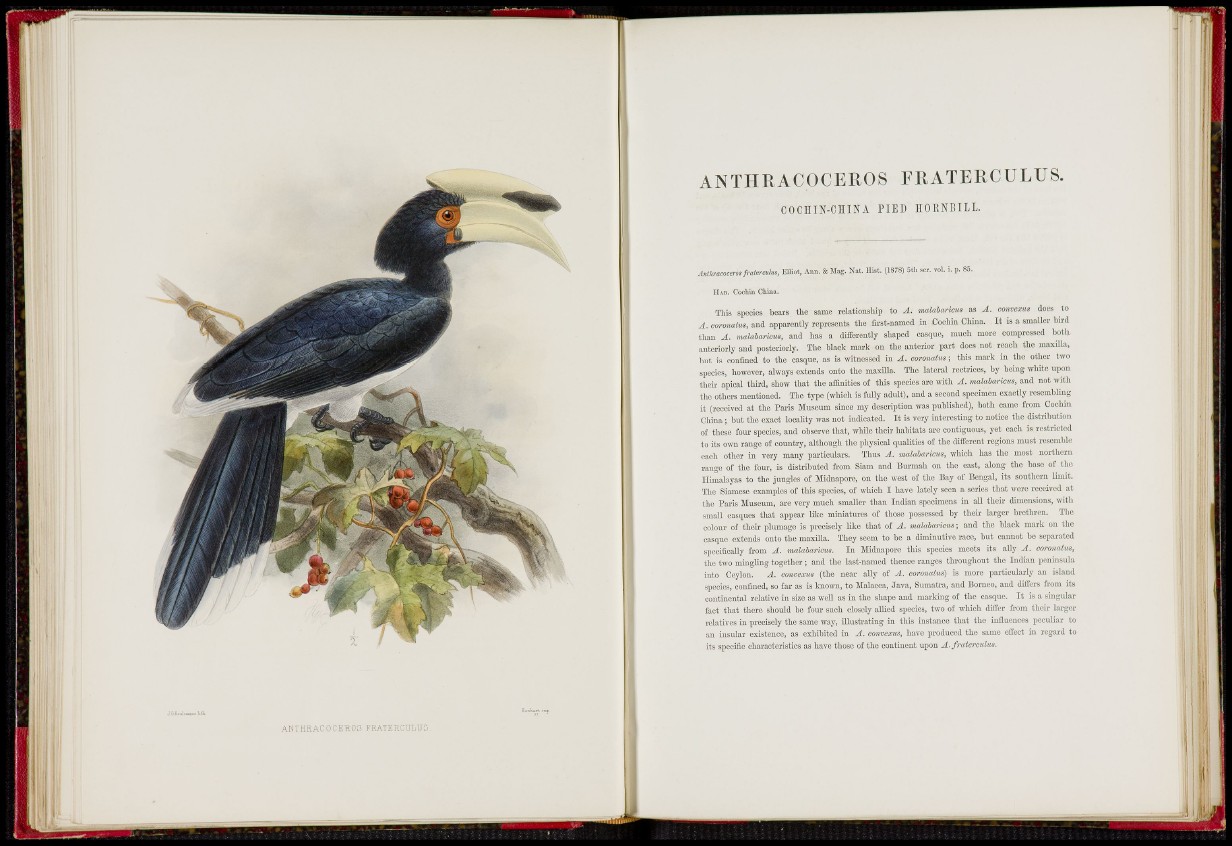
ANTHRACOCEROS FRATERCULUS.
C O C n i N - C n i N A PIED HOKNBILL.
Antkracocerosfraterculus, Elliot, Ann. & Mag. Nat. Hist. (1878) 5tli ser. vol. i. p. 85.
H-VB. Cochin Chiua.
This species bears the same relationship to A. malabaricus as A. convexiis docs to
A. coronatus, and apparently represents the first-named in Cochin China. It is a smaller bird
than A. malabaricus, and has a differently shaped casciue, much more compressed both
anteriorly and posteriorly. The black mark on the anterior part does not reach the maxilla,
but is confined to the casque, as is witnessed in A. coronatus-, this mark in the other two
species, however, always extends onto the maxiUa. Tho lateral rectrices, by being white upon
their apical third, show that the affinities of this specics are with A. malabaricus, and not with
the others mentioned. The type (which is fully adult), and a second specimen exactly resembling
it (received at the Paris Museum since my description was published), both came from Cochin
C;iiina; but the cxact locality was not indicated. It is very interesting to notiec the distribution
of those four species, and observe that, while their habitats arc contiguous, yet eacli is restricted
to its own range of country, although the physical qualities of the diiferent regions must resemblci
each other in very many particulars. Thus A. malabaricus, which has the most northern
range of the four, is distributed from Siam and Burmah on the east, along the base of the
Himalayas to the jungles of Midnapore, on the west of the Bay of Bengal, its southern limit.
The Siamese examples of this species, of which I have lately seen a scries that %vere received at
the Paris Museum, are very much smaller than Indian specimens in all their dimensions, with
sraali casques tliat appear like miniatures of those possessed by their larger brethren. Tlic
colour of then- plumage is precisely like that of A. malabaricus-, and the black mark on tlic
casque extends onto the maxilla. They seem to be a diminutive race, but cannot be separated
specifically from A. malabaricus. In llidnapore this species meets its ally A. coronatus,
the two mingling together; and the last-named thence ranges throughout the Indian peninsula
iuto Ceylon. A. convexus (the near ally of A. coronatus) is more partieulariy an island
species, confined, so far as is known, to Malacca, Java, Sumatra, and Borneo, and dificrs Irom its
continental relative in size as wcU as in the shape and marking of the casque. It is a singular
fact that there should be four such closely allied species, two of which differ from their larger
relatives in precisely the same way, illustrating in this instance that the influences peculiar to
an insular existence, as exhibited in A. convcxus, have produced the same effect in regard to
its specific characteristics as have those of tlic continent upon A. frater cuius.
mam